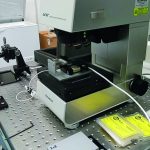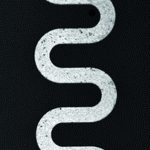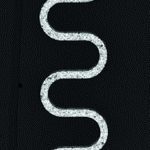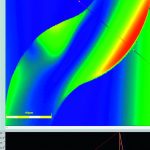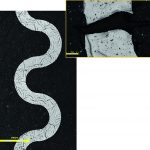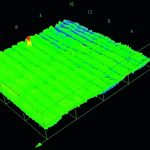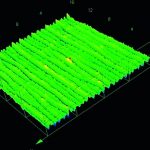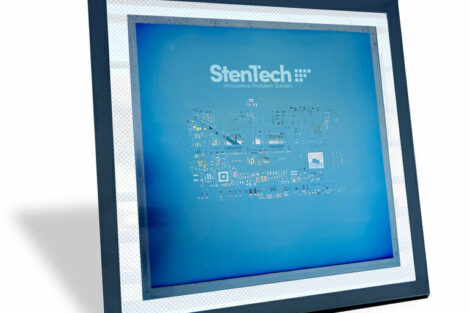Researcher Dr Dario Gastaldi has found confocal laser scanning microscopy yields many advantages in his investigations into flexible electronics. Through in situ reliability testing, his group has generated quantitative evidence to determine device integrity under strain, facilitating numerical modelling systems for optimising the design process – while also revealing additional insights.
Markus Fabich, Product and Application Specialist for Materials Science Microscopy, Olympus Europa SE & CO. KG
Intense research and development efforts are bringing us ever closer to the era of flexible electronics. In one popular design, electrical components supported by a deformable substrate are linked via flexible conducting interconnects, where components and substrate must be connected in order for a flexible electronic device to function. As such, the interconnect must be precisely engineered to remain attached to the substrate during complex deformation. In driving the development of more robust flexible electronics, understanding how mechanical behaviour evolves with strain is key, and this is where in situ reliability testing presents a valuable approach. Applying exact amounts of strain to a sample while monitoring the response with high-resolution imaging provides an accurate and detailed picture of how the device responds to strain. This can guide the optimisation of both the component materials and the fabrication process, but the information acquired depends on the imaging technique applied. While scanning electron microscopy (SEM) has traditionally been used to observe in situ testing experiments, light microscopy has now advanced to a stage where its capabilities are comparable to SEM. Moreover, confocal laser scanning microscopy (CLSM) also includes the added advantages of speed, ease of use and the ability to gather quantitative information.
At the Politecnico di Milano (Milan, Italy), Dr Dario Gastaldi’s research group has applied in situ testing of flexible electronic samples coupled to CLSM for investigating and optimising interconnect design. A modular micro-tensile device fits on the stage of the Olympus LEXT OLS4100 confocal laser scanning microscope, and strain is applied in 5 % increments, with images acquired after each step. With this setup, Dr Gastladi’s group is working to understand and guide the two main features that have been found to affect adhesion between the interconnect and polymer substrate: geometric parameters and the fabrication process itself.
Ideal interconnect geometry
The differing interconnect geometries are defined by width, radius and length, and testing a variety of samples under mechanical strain provides insights into their differing mechanical behaviour. SEM was previously employed with the in situ mechanical testing device, and although this technique has a resolution greater than CLSM, it fails to allow precise quantification of out-of-plane deformation. “This is exactly what we need, as we were not satisfied with a qualitative view,” said Dr Gastaldi. “Looking at the intensity image, they are really very similar to the SEM. I was impressed by the image quality, not to mention the quantitative information. ”Advancing research into flexible electronics, quantitative measurements are vital for the development of numerical models and therefore the complete design cycle, guiding the fabrication based on mechanical properties or geometrical design. This was enabled by the Height Map function, and Dr Gastaldi commented: “The quality of measuring a 3D structure with such accuracy exceeded expectations. Now we have the LEXT, we have not performed any SEM acquisition with our in situ mechanical testing device.”
The key geometrical parameter was found to be the length of the strut (or ‘amplitude’), and CLSM also allowed the study of kinematics (geometry of motion) during mechanical testing to support this finding. Stretching causes compaction in the transverse direction, thus compacting the strut and leading to delamination due to buckling. Shorter struts exhibit less rotation (A versus B), as kinematic rotation can occur if metal delaminates from the substrate. Shorter struts are not prone to promote the buckling effect, and such a mechanical structure tends to accommodate much higher deformation. However, the structural mechanical behaviour of this tiny part is not only defined by the geometrical features, but also the adhesion properties between the metal and polymer.
Optimising adhesion between the interconnect and substrate
The manufacturing process dictates the level of adhesion between the metallic interconnection and the polymer substrate. With this adhesion being central to functionality, optimum manufacturing guarantees maximum performance in terms of withstanding deformation.
For example, in gold on Polydimethylsiloxane (PDMS) polymer samples, plasma treatment of the polymer surface is a standard technique employed to increase adhesion. “The plasma treatment permanently modifies the polymer, so the question we want to ask is this – is the modified polymer compatible with deformation?”One side effect of the treatment is an increase in brittleness of the polymer, and Dr Gastaldi’s group has found this promotes superficial cracks and reduces the deformation that PDMS can sustain. However, the treatment protocol can be controlled through parameters such as energy and duration, and in situ mechanical testing with CLSM allows comparison between samples subjected to varying treatments. As such, it is possible to identify the optimal plasma process, guaranteeing good adhesion without crack formation under a certain level of strain.
Moreover, Dr Gastaldi’s work also found these cracks are present prior to the metallisation process, confirming the brittleness derives from the plasma treatment alone. “With the LEXT, we have observed the cracks increase with strain, so we are now able to communicate this to our partners working on the manufacturing technique. We have evidence to show that certain plasma treatments limit the mechanical strength of the device, and the metallisation process is not the problem.”
Summary
The work of Dr Gastaldi’s group focuses on optimising the interconnect geometry and manufacturing process for flexible electronics, using in situ mechanical testing to provide insightful data of device behaviour under strain. Combined with the quantitative information from the Olympus LEXT OLS4100, this approach has opened new avenues, advancing the design of flexible electronic devices.
Quantitative evidence now supports how particular geometries with shorter ‘amplitude’ values are more resistant to delamination, facilitating the development of a numerical modelling system to enhance the design process. Moreover, quantitative information has also helped to reveal that plasma treatment of polymers may increase adhesion, but promotes cracking at lower levels of strain. “The easy management of the LEXT allows us to focus our attention on our research,” commented Dr Gastaldi, who affirmed: “For those working with different types of mechanical testing, 3D profilometry is a really new, exciting aspect to this research. CLSM provides us with a step forward, and now the question is how far can we go with this technique, and how can we couple the quantitative imaging capabilities of CLSM with other techniques to drive the development of flexible electronics?”
Share:


